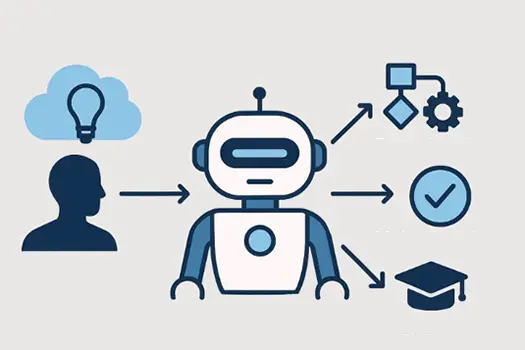
Agentic AI explained: from automation to autonomy
The new frontier of AI
Generative AI has shown us that machines can create. But what if they could also act? This is the promise of agentic AI, a major leap forward that moves artificial intelligence from being a reactive tool to a proactive, autonomous partner.
While traditional automation follows a rigid, pre-defined set of rules, agentic AI is designed to make its own decisions to achieve a high-level goal. It's the difference between a robot on an assembly line that performs the same task repeatedly and a self-driving car that navigates complex, unpredictable city streets to reach a destination.
This post will demystify this powerful concept, distinguish it from simple AI automation, and introduce you to some of the most popular platforms and tools that are making agentic AI a reality.
Understanding Agentic AI: the loop of autonomy
At its core, an AI agent is a system with the ability to reason, plan, and act on a user-defined goal. It operates in a continuous loop:
- Perception (Observe): The agent takes in information from its environment, such as a user prompt, web data, or API outputs.
- Reasoning (Think): It uses a large language model (LLM) as its "brain" to analyze the information and break down a complex goal into smaller, manageable steps.
- Action (Act): It executes a step, often by using external tools like search engines, APIs, or software programs.
- Feedback (Reflect): It evaluates the outcome of its action and decides on the next step. If it fails, it can adjust its plan and try again.
This dynamic, iterative process is what gives agentic AI its power. It can adapt to new information, recover from errors, and execute complex, multi-step tasks without constant human intervention.
Agentic AI vs. AI Automation: the key difference
The terms "AI automation" and "agentic AI" are often used interchangeably, but there's a critical distinction rooted in their level of autonomy.
- AI Automation: Think of this as a smart recipe. You provide the inputs, and the system follows a fixed, pre-programmed sequence of steps. For example, a marketing automation tool might send an email newsletter to a subscriber list every week. The steps are predictable and don't change.
- Agentic AI: Think of this as a problem-solver. You give it a high-level objective, and it figures out the best way to achieve it. It can choose different tools, change its plan based on new information, and even ask for help when needed. A good example is an AI agent tasked with "researching the best marketing channels for a new product and drafting a strategy." It would autonomously search the web, analyze data, and write the report without a pre-set path.
While both aim to reduce manual work, agentic AI is not just faster; it's smarter. It brings a level of intelligence and adaptability that goes beyond simple rule-based automation.
Popular tools and platforms for Agentic AI
The field is rapidly evolving, with new tools emerging constantly. Here are some of the most influential platforms that are making agentic AI accessible to both developers and general users.
Frameworks for Developers
These tools provide the foundational building blocks for creating your own agents. They're popular for their flexibility and control.
- LangChain: A widely-used framework that simplifies the process of building applications powered by LLMs. It offers a structured way to chain together different components, enabling developers to create agents that can use external data and tools.
- CrewAI: This framework is designed specifically for orchestrating multi-agent systems. It allows you to create a "crew" of specialized AI agents that work together to accomplish a shared goal, much like a team of human collaborators.
- AutoGen: Developed by Microsoft, AutoGen enables the creation of conversational agents that can communicate and collaborate to solve tasks. It's particularly useful for building systems where agents need to work together to complete a complex workflow.
User-Friendly Platforms
These tools are great for those who want to build and use agents without writing extensive code.
Lindy.ai: This platform lets you create custom AI assistants called "Lindies" for tasks like managing emails, scheduling meetings, and generating leads. It's a great example of no-code agentic AI in action.
AgentGPT: A popular web-based tool that allows you to configure and run an AI agent by simply defining a goal. It visually shows the agent's thought process as it breaks down and executes the task, offering a clear glimpse into the agentic loop.
n8n: This is a powerful workflow automation tool that has integrated agentic AI capabilities. It allows you to mix traditional automation steps with AI agents, giving you the best of both worlds for building robust and reliable workflows.
Specialized Agent Tools
Some tools are single-purpose agents that solve a specific problem.
Perplexity: While known as a search engine, Perplexity can act as a powerful research agent. It autonomously searches the web, synthesizes information from multiple sources, and provides a comprehensive, cited summary, going far beyond a simple search query.
Synthesia: In the video space, Synthesia uses AI agents to generate realistic video content from text scripts, autonomously creating avatars and scenes with minimal user input.
Conclusion: the path to practical AI
Agentic AI represents a maturation of artificial intelligence, moving it from a curiosity to a truly useful, goal-driven technology. By understanding the core concept of the autonomous agentic loop and the key difference from simple automation, you are better equipped to navigate this new era of AI. The future is not just about intelligent tools; it's about intelligent partners that can take initiative and help you achieve complex goals, freeing you to focus on the high-level strategy and creativity that only humans can provide.

